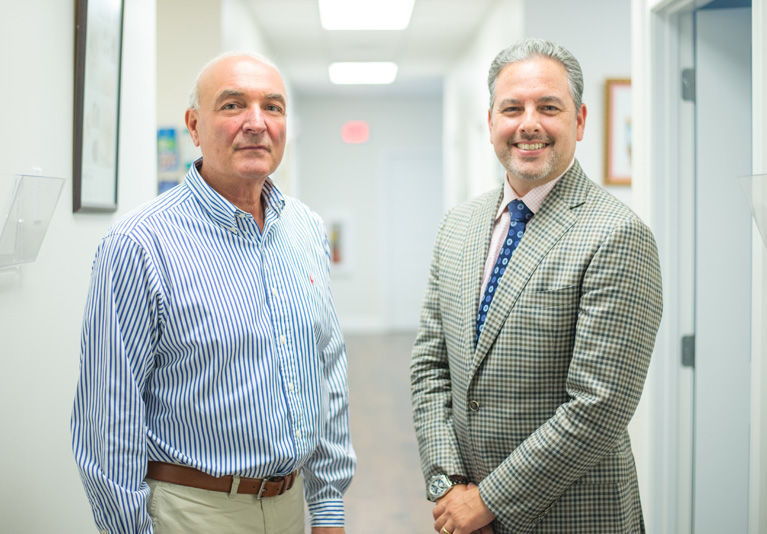
Dr. Hugo Davila and Dr. Jay Colella are looking to stop kidney cancer cold.
The American Cancer Society estimates that about 62,000 new cases of kidney cancer will be diagnosed this year and roughly 14,000 people in the U.S. will die from the disease. The Society also claims that, “the rate of new kidney cancers has been rising since the 1990s,” but here in Indian River County, Davila and Colella are committed to freezing kidney cancer in its tracks.
Literally.
Their weapon of choice? Cryoablation.
Also known as cryosurgery or cryotherapy, cryoablation is a treatment used to kill cancer cells with extreme cold. In other words, freezing tumors to death.
Without using scalpels to cut into vital working organs, Davila of Indian River Urology Associates and Colella, an interventional radiologist with Sebastian River Medical Center, just performed a first-of-its-kind on the Treasure Coast procedure to locate, isolate and kill a kidney cancer tumor before it had a chance to metastasize and spread throughout the patient’s body.
“We are so excited,” exclaims Davila, “because [now] the community can have the same standard of care that they will get in the Mayo Clinic or Memorial Sloan Kettering. What we are providing here in Sebastian is the same standard of care as any cancer center.”
Relying on guidance from the American Urology Association, Davila and Colella didn’t just jump into this procedure. According to Colella, “It took a while to plan this because we had to establish criteria for privileges. We had to establish a relationship with a company that provides the equipment for us to do it. We’ve been working on it probably for a year.”
The National Cancer Institute offers a concise description of the benefits of cryosurgery saying it, “Offers advantages over other methods of cancer treatment. It is less invasive than surgery, involving only a small incision or the insertion of the cryoprobe through the skin. Consequently, pain, bleeding and other complications of surgery are minimized. Cryosurgery is less expensive than other treatments and requires shorter recovery time and a shorter hospital stays, or no hospital stay at all.” Indeed, the procedure can often be done using only local anesthesia.
The National Institutes of Health go even further.
NIH reports that, “Because physicians can focus cryosurgical treatment on a limited area, they can avoid the destruction of nearby healthy tissue. The treatment can be safely repeated and may be used along with standard treatments such as surgery, chemotherapy, hormone therapy and radiation. Cryosurgery may offer an option for treating cancers that are considered inoperable or that do not respond to standard treatments. Furthermore, it can be used for patients who are not good candidates for conventional surgery because of their age or other medical conditions.”
So how does cryosurgery work?
The Mayo Clinic’s description states that, “During cryoablation, a thin, wand-like needle called a cryoprobe is inserted through the skin and directly into the cancerous tumor. [Argon] gas is pumped into the cryoprobe in order to freeze the tissue. Then the tissue is allowed to thaw. The freezing and thawing process is repeated several times during the same treatment session.”
The argon gas never actually touches the tissue. Instead, it is recirculated within the needle-thin cryoprobe, producing temperatures as low as minus 140 degrees Fahrenheit according to Davila.
Aside from its role in treating kidney cancer, the Mayo Clinic lists bone cancer, cervical cancer, eye cancer, liver cancer and lung cancer as conditions for which
cryoablation can be used as a primary treatment.
Ah, but there’s a catch as Davila freely admits: The size of the tumor matters.
Citing those American Urology Association, Davila explains that, “A tumor that is less than four centimeters,” (about one-and-a-half inches), is best suited to this procedure. In fact, Davila warns that, “When you get symptoms from kidney cancer, it’s usually too late,” for cryosurgery. Those symptoms can include blood in the patient’s urine, back pain, abdominal pain and sometimes even being able to feel the tumor when touching the abdomen.
Fortunately, as Colella points out, new imaging technologies such as CT scans are able to discover smaller, early-stage kidney tumors more readily than ever before.
“Most renal cell carcinomas these days,” Colella explains, “are discovered incidentally.” That is, a patient may have a CT scan as part of an annual physical or something else but the radiologist or a primary care physician spots the tumor and then sets the patient on a path to treatment.
Is cryoablation the long-sought “cure for cancer” the world has always wanted?
No. But as Colella puts it, “We have all different methods for treating cancer and other diseases and the more tools you have in your tool kit, the better you can customize the treatment specifically to the patient’s needs.”
Dr. Hugo Davila is with Indian River Urology Associates. His office is at 1627 U.S. Hwy. One, Suite 201 in Sebastian. The number is 772-388-8858. Dr. Jay Colella is an interventional radiologist. He can be reached through the Sebastian River Medical Center.



